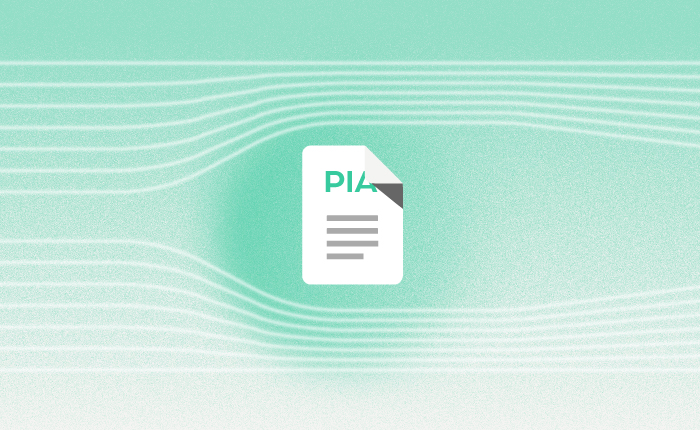Privacy Impact Assessments (PIA) are compliance efforts that help organizations identify and manage risks to personal information, assess gaps and issues from new or changes to existing practices, and align business practices and product offerings to particular privacy-compliance obligations.
Any organization that handles personal data should understand whether the data is inherently privacy-sensitive or could be if combined with other data; how it would be used or disclosed; whether there are particular statutory, regulatory or contractual obligations that must be met; and whether there may be potential negative impacts to the individuals concerned.
Below, we’ll cover the Privacy Impact Assessment meaning and discuss two ways you can tackle these assessments from start to completion.
What is the Purpose of a Privacy Impact Assessment?
If your organization handles personal data, conducting ongoing PIAs will help you methodically identify compliance or operational gaps that, if not addressed, can spiral out into brand-damaging incidents and scandals all too common in today’s hypercharged news cycle.
For example, per the Colorado Attorney General, a privacy review under the new Colorado Privacy Act (called a Data Protection Assessment) should:
- Identify and describe all risks that the processing activities posed that can be considered a “heightened risk of harm to a Consumer”
- Document the assessment steps taken to mitigate potential risks
- Review whether the processing activity’s benefits are worth pursuing
- Demonstrably show the processing activity’s benefits outweigh potential risks
While not always, heightened risk can result from handling data that is inherently sensitive.
Example data includes:
- Government IDs like Social Security Numbers
- Ethnic origins data
- Health and ailment information
- Precise geolocation
- Communication contents and browsing history
- Financial account numbers when paired with account credentials
Given the potential harm that can occur if this kind of information is misused, abused, or compromised, many organizations are obligated to conduct formalized PIAs.
In most cases, privacy issues or risks can be challenging to identify if:
- You collect data from various sources (e.g., official websites, email).
- Your business operations span multiple locations (e.g., Europe, North America).
- You process personal information over a large IT infrastructure comprising various types of assets.
In general, risk awareness is built into PIAs and their GDPR-mandated versions, Data Protection Impact Assessment or DPIA, to help organizations catch potential privacy risks early on in their lifecycle.
Let’s explore two ways you can streamline Privacy Impact Assessments.
#1 Determining When to Complete a Privacy Impact Assessment
Taking cues from the Securities and Exchange Commission (SEC), one of a number of US federal agencies required to conduct Privacy Impact Assessments under the E-Government Act of 2002, you should complete a Privacy Impact Assessment if you are:
- Optimizing or implementing new technologies, processes, or systems to handle personal data
- Modifying a system currently in use to process personal data
- Implementing a new method to collect personal data from more than 10 persons
- Expanding business operations internationally
You may not be required to complete a PIA for each system or process within your tech stack nor would it be meaningful if you are assessing a business process, project or opportunity. Nevertheless, you will need to gather as much factual information as possible about the activity and any relevant technologies that may be involved. This intelligence will be critical to the success of the assessment.
There may also be specific instances where a Privacy Impact Assessment is not strictly required but recommended as a matter of best practice. It’s always best to consult a designated Privacy Officer under these circumstances—a decision to not document a PIA may also need to be documented.
#2 Determining Whether to Complete a Data Protection Impact Assessment
Until recently, privacy impact assessments were associated primarily with the General Data Protection Regulation (GDPR), the European Union’s (EU) stringent data privacy framework with a global reach.
But, more jurisdictions—notably the US State of California with the Consumer Privacy Rights Act (CPRAA)—are enshrining the practice as an enforceable necessity. PIAs are not longer just for government agencies, public sector companies and highly regulated industry sectors. All organizations are encouraged to get into the habit of assessing their privacy practices and implementing appropriate privacy safeguards.
Regulatory guidance for the GDPR is comprehensive. European data protection authorities prescribe DPIAs when you, for example, are:
- Using new or novel technologies such as ML/AI
- Engaging in large-scale processing activities
- Collecting data on people’s locations or behavior
- Monitoring persons’ activities in public spaces
- Processing special categories of GDPR personal data (i.e. sensitive data)
- Making fully automated decision about individuals with a legal or equally significant effect
- Handling children’s data
These and other relevant factors must be considered as part of a thoughtful DPIA. This ensures that business needs can be balanced against the privacy rights, freedoms and reasonable expectations of individuals. And that appropriate technical and organizational controls could be applied reduce the likelihood of data misuse or abuse.
Go Beyond Mere Compliance with DataGrail
If you are looking for a robust tool to automate privacy rights requests, generate dynamic records of processing activity, or conduct DPIA/PIAs, then DataGrail can help. We empower your team to create and manage privacy assessments, as required by GDPR, CCPA/CRPA, and wherever privacy legislation is enacted in the future.
We cut down manual work by auto-populating assessment templates using our deep integrations, saving you and your technical teams from hunting for personal data in your tech stack… or flip through binders of contracts and legalese.
To learn more, check out DataGrail’s data privacy platform.
Sources:
California Legislative Information. California Consumer Privacy Act (CCPA). https://leginfo.legislature.ca.gov/faces/codes_displayText.xhtml?division=3.&part=4.&lawCode=CIV&title=1.81.5
Code of Colorado Regulations. Colorado Privacy Act Rules. https://coag.gov/app/uploads/2022/10/CPA_Final-Draft-Rules-9.29.22.pdf
EU GDPR. Data Protection Impact Assessment (DPIA). https://gdpr.eu/data-protection-impact-assessment-template/SEC. Privacy Impact Assessment (PIA) Guide. https://www.sec.gov/about/privacy/piaguide.pdf
